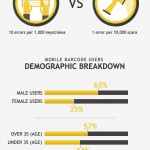Wasp Barcode Technologies: The Barcode Solution People
Barcode: Happy 62nd Birthday!

The anniversary of the
barcode’s patent is October 7—making today the barcode’s birthday. From adding items to a gift registry to scanning products for purchase, barcodes are an integral part of the shopping and sales process. However, in the modern world, barcodes are also used for a number of purposes outside of scanning items for purchase.
Since today marks its 62
nd birthday, Wasp would like to celebrate the occasion by providing you with a bit of interesting information about our versatile friend. With
barcodes helping to save businesses money, preventing medication errors, and maintaining consumable inventory and fixed asset information, help us celebrate this resourceful tool by learning more about its history and how it’s currently used.
Origins
The need for the barcode first became apparent in the 1930s when the grocery business began to boom and inventory became increasingly more difficult to track. However, the patent for the barcode was not issued until 1952, after Norman Joseph Woodland developed the first, four-lined barcode system.
For more information about the barcode and its history, visit Wasp’s previous birthday posts:
The Barcode Today

Barcodes have come a long way since the 1930s. Although they were initially used in the grocery industry, they are now utilized by a variety of other fields, including: shipping, military, healthcare, and science industries. In fact, the barcode is so pervasive in today's society that it can be seen throughout the day in many different locations, from hospital ID bracelets to QR codes on advertisements.
UPC Codes/ 1-D Barcodes
Although many different types of barcodes are in use, the most common barcode is the UPC. UPC stands for "Universal Product Code" and is used on the majority of products sold in stores. Standard UPC codes are 12 digits in length. The first six digits make up the manufacturer’s identification number, which is a unique number issued to a manufacturer in exchange for an annual fee. The next five digits in the UPC code make up the item number, which is assigned to each individual item. The final digit is known as the "check digit." The check digit is used to ensure the scanner reads the number correctly. All UPC codes are unique to ensure products are accurately identified by their barcodes.
Barcode scanners read the values of each of the 12 digits in the UPC code by using specialized technology to evaluate the width of the bars. Humans can determine the UPC code by simply reading the digits printed beneath the bars. Thus, if the barcode becomes damaged or distorted, a human can enter the product code manually.
2-D Barcodes/QR Codes
Two-dimensional barcodes, such as QR codes, are complex barcodes that can hold a great deal of information. These codes contain various black and white patterns which allow the
QR code scanner to evaluate the barcode's size, determine whether it is distorted, and decode the information stored within the code. QR codes can be scanned by a number of devices, including smartphones. To read about a few very creative uses of these codes, please visit our recent post—
Creative and Unique Uses for QR Codes.
The Future of the Barcode
Barcodes are an essential tool for businesses everywhere, and, as they make our lives easier, we can expect to use them for many years into the future. In fact, as time goes on, we should anticipate the discovery of even more innovative uses for barcodes. Happy birthday, barcode! We can't wait to see what you do next.
[caption id="attachment_6682" align="aligncenter" width="150"]

Barcode Birthday Infographic[/caption]
Need to create a barcode or QR code of your own? Use our free generators:


 The anniversary of the
The anniversary of the  Barcodes have come a long way since the 1930s. Although they were initially used in the grocery industry, they are now utilized by a variety of other fields, including: shipping, military, healthcare, and science industries. In fact, the barcode is so pervasive in today's society that it can be seen throughout the day in many different locations, from hospital ID bracelets to QR codes on advertisements.
Barcodes have come a long way since the 1930s. Although they were initially used in the grocery industry, they are now utilized by a variety of other fields, including: shipping, military, healthcare, and science industries. In fact, the barcode is so pervasive in today's society that it can be seen throughout the day in many different locations, from hospital ID bracelets to QR codes on advertisements.





